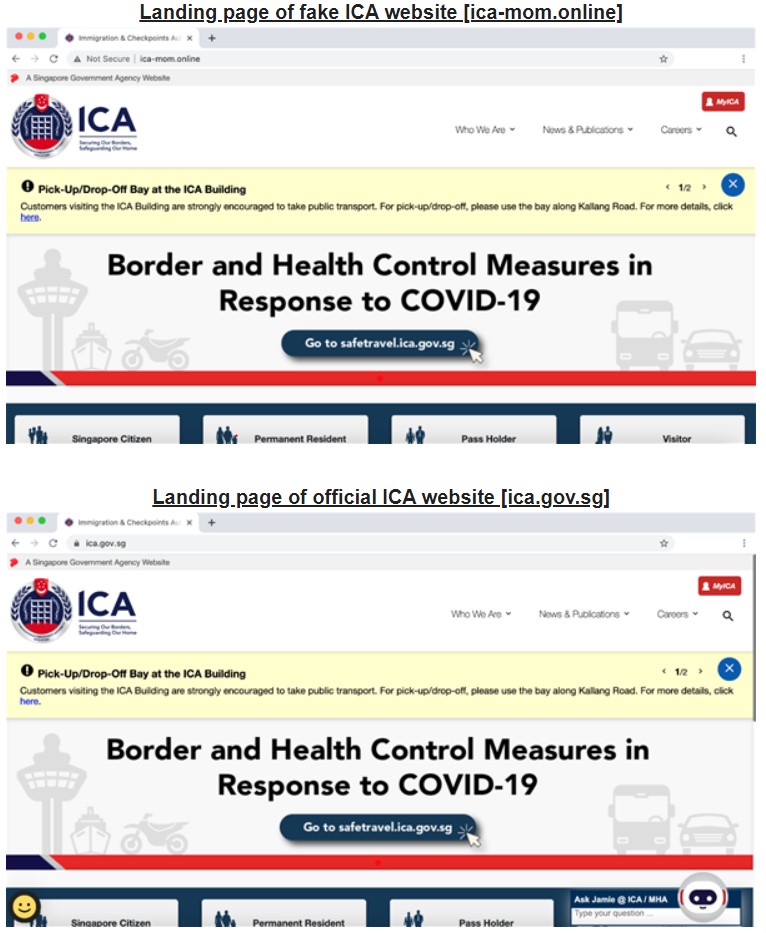HTX’s newest innovation hunts own phishing websites to keep Singapore’s cyberspace safe.
At first glance, these two ICA websites look completely identical. Only upon closer inspection, does the viewer realise that the URLs are different. But to the Online Cybersquat Hunter, the differences are blindingly obvious.

Figure 1. Screenshot of ICA Public Advisory (Credit: ICA)
Online phishing scams, such as the fake ICA one above, have seen a tenfold increase from 2019 to 2020. Many malicious websites pose as official websites to deceive victims into divulging sensitive information, such as passwords and credit card details.
In many cases, these sites are only reported to the police after the scammers have already gained access to the victim’s information and the damage is done.
That is why HTX’s Q Team Centre of Expertise made it their mission to pre-emptively hunt down these malicious sites and exponentially increase police efforts in shutting down scams – by creating the Online Cybersquat Hunter (OCH).
How it works
The OCH uses AI with image and text analytics to automatically detect fake sites before they are even reported.
It does this by crawling through up to 500,000 websites on the public domain daily to see if they contain domain names, logos, and key words similar to those used on official websites.
OCH Project Team
Ng Gee Wah – Director, Q Team
Terence Tan – Deputy Director (DD), Q1
Tan Wei Lin – Engineer, Q1
Lim Ming En – Engineer, Q1
Michael Tay – DD Cybersec Ops, Ops Sys SC; DD Exercise & Evaluation, CS COE
Lucas Kan – Head, Cybersec SOC Ops, Ops Systems SC

Figure 2. From left to right: Engineer Tan Wei Lin, Director Ng Gee Wah, Deputy Director Terence Tan, Engineer Lim Ming En. Deputy Director Michael Tay and Head of Cybersecurity Operations Lucas Kan are not pictured. (Credit: HTX)
Development
Q Team worked with inputs from the Ministry of Home Affairs’ (MHA) Security Operations Centre and Singapore Police Force – developing, prototyping, and rigorously testing out many iterations before settling on the current version.
“At every tool developmental phase, there was significant active discussions, brainstorming of more ideas, defining and shaping attributes that could help us identify fake websites,” said Q Team’s deputy director Dr Terence Tan.
After an intensive month of rapid development, the OCH was deployed in Dec 2020 and has been in use ever since.
Applications
Currently, the OCH is focused on scanning for fake websites targeting MHA’s public service websites, such as the Singapore Police Force, Singapore Civil Defence Force, and ICA. Some key local banks and online delivery services are on trial as well.
“Our technology becomes more sophisticated and better at delivering outcomes, as we understand more about these websites through information gathering as quickly as possible. As our algorithm improves, our outcomes will increase exponentially as well,” said Dr Tan.
Q Team will continue to develop OCH to make it more effective and efficient, ensuring that our cyberspace will be a safer place for all.
The OCH was also covered in the Straits Times on 26 May 2021.
‘Hunter’ targets scam sites in S’pore, even before they can trick people

![[FEATURED NEWS] Beating hi-tech scams with hi-tech systems](/Cwp/assets/htx/images/listing-card-placeholder.png)